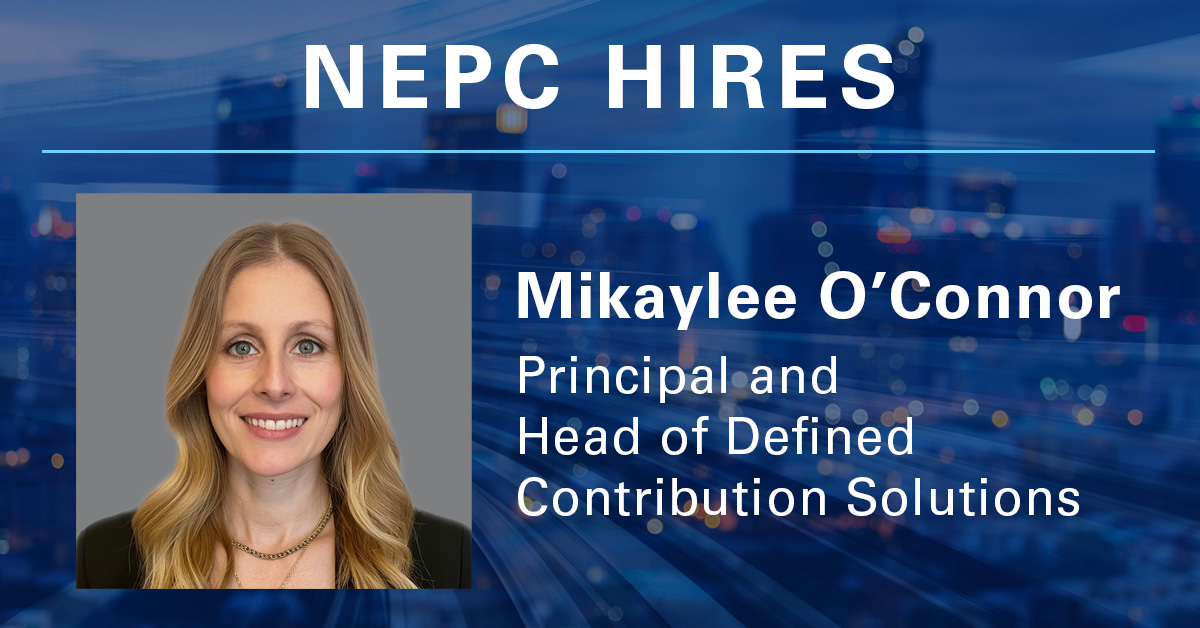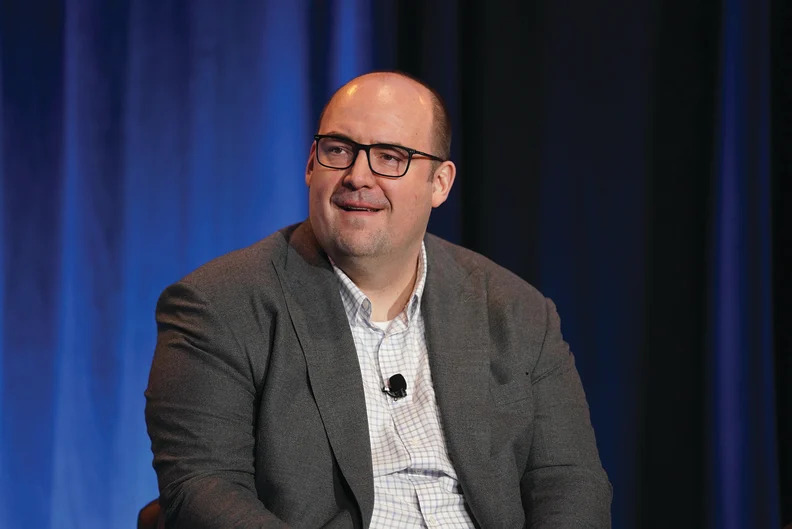PlanSponsor: How Employers Can Afford to Fund Auto-Features
In this PlanSponsor article, NEPC’s Mikaylee O’Connor shares her perspective on the value of automated plan features and practical strategies employers can use to support and fund them. Read the full piece on PlanSponsor’s website.
The retirement security of millions of working Americans is becoming increasingly reliant upon an asset structure that is likely less familiar than its ubiquitous counterpart, but powerful to many.
. . .
Today, more than half of defined contribution retirement plans have adopted automatic enrollment: According to NEPC’s 2024 Annual Plan Trends & Fee Survey, released in March, 54% of DC plans used auto-enrollment and 59% offered auto-escalation.
. . .
“Starting early and saving enough are the most powerful drivers of retirement success, and auto-enrollment and [auto-]escalation make both happen seamlessly,” wrote Mikaylee O’Connor, principal in and head of DC solutions at NEPC LLC, in a response to emailed questions. “These features remove friction, boost participation and lead to more financially secure employees—translating into higher productivity, engagement and satisfaction.”
. . .
NEPC’s O’Connor wrote to PLANSPONSOR that in addition to adjusting allocations within the retirement budget, plan sponsors might also consider integrating health care and retirement into a single benefits strategy. Opportunities often exist in health care to reduce costs by revisiting plan design and better understanding current fee arrangements—potentially leading to renegotiations or better alignment of overall incentives, O’Connor explained.
For health plan design, sponsors can evaluate options such as offering high-deductible plans instead of preferred provider organizations, O’Connor wrote. Fee reviews can include examining provider fee transparency—potentially revealing opaque incentives or compensation structures—and assessing payment accuracy, as a significant portion of payments are often miscalculated.
. . .
O’Connor sees another opportunity in the auto-feature space.
“The next frontier is auto-distribution, creating a paycheck-like experience for retirees,” wrote O’Connor. “This keeps assets in the plan while simplifying income delivery—a win-win for sponsors and participants.”
Click here to read the full article on the PlanSponsor site.
Planadviser: Rapid Growth in CITs Fueled by Small Plan Adoption
NEPC’s Bill Ryan is quoted in this PLANADVISER article discussing the rapid growth of collective investment trusts (CITs)—particularly how small plan adoption is fueling their rise—and why lower fees are a key driver. Visit PLANADVISER to read the full article.
Collective investment trusts now hold nearly 30% of DC plan assets, rising from just 13% a decade ago; experts predict it won’t be long before they overtake mutual funds’ role in the defined contribution market.
. . .
“There are [several] macro factors driving [CIT] adoption,” says Bill Ryan, a partner and defined contribution team leader at NEPC. “No. 1 is lower fees for CITs relative to [fees for] mutual funds.”
. . .
“For a while, mutual fund companies either didn’t have a CIT to provide to small plans, or priced it in a way that you had to have over a certain asset level to access CITs—so that CITs didn’t cannibalize their mutual fund business,” Ryan explains.
He adds that asset managers now prefer CITs because there are fewer cost burdens and less friction associated with the structure. That’s why small plans are catching on, he says.
. . .
Usually, however, problems such as a recordkeeper lacking the right subscription documents for a new CIT or share class can slow down the transition process by “weeks, not months or years,” Ryan says.
“If there was a wrinkle, … it’s akin to what mega plans had 15 or 20 years ago,” he says. “It’s new, it’s different, so you just need to explain that you’re getting the same stocks in both portfolios … you’re just getting different wrapping paper.”
Click here to continue reading the full PLANADVISER article.
Planadviser: The Evolution of the DCIO Sales Model
NEPC’s Bill Ryan is featured in this PLANADVISER article, which explores how DCIO firms are shifting their sales models to focus more on centralized relationships with CIOs and home office decision-makers. Visit PLANADVISER to read the full article.
Investment firms are increasing emphasis on developing relationships with CIOs and others responsible for approved fund lists and 3(38) programs.
. . .
Bill Ryan, a partner in, and DC team leader at, NEPC, says DCIO sales teams seem to have a greater appetite to be creative for the end client because of the centralization.
“There becomes more of a focal point for them to figure out what the scale and leverage [are] versus wider distribution, where you’re more tethered to the off-the-shelf products,” Ryan says. “[The centralization] allows the RIAs and institutional consultants to be more creative with their clients and [devise] maybe more bespoke solutions that they can scale for their client base.”
DCIOs that are successful have a centralized enterprise relationship manager who works with clients’ home office, he adds.
. . .
Ryan says there could be hyper-consolidation among the DCIO firms, with some deciding to retreat from the DCIO space and concentrate on the wealth channel and annual rollovers. But the state of the industry now poses an opportunity for the DCIO sales teams.
“There is an urgency now that I haven’t seen before with the centralized decisionmakers that you can actually effect change,” Ryan says. “I think there’s going to be a tipping point—I don’t know if it’s two or three or five years from now—but the door could close. This is a really exciting window for entrepreneurs in the DCIO sales force to deliver interesting products to DC plans.”
Click here to continue reading the full PLANADVISER article.
PlanSponsor: CITs Expand, Go Smaller
NEPC’s Bill Ryan recently spoke with PLANSPONSOR about the growing adoption of Collective Investment Trusts (CITs), noting how fee transparency and evolving plan design are driving greater accessibility for smaller plans. Read the full article on PLANSPONSOR or read excerpts below.
The retirement security of millions of working Americans is becoming increasingly reliant upon an asset structure that is likely less familiar than its ubiquitous counterpart, but powerful to many.
. . .
“There are [several] macro factors driving [CIT] adoption,” says Bill Ryan, partner and defined contribution team leader at NEPC. “Number one is lower fees for CITs relative to mutual funds.”
. . .
“For a while, mutual fund companies either didn’t have a CIT to provide to small plans, or priced it in a way that you had to have over a certain asset level to access CITs—so that CITs didn’t cannibalize their mutual fund business,” explains NEPC’s Ryan.
He adds that asset managers now prefer CITs because there is less friction and fewer cost burdens associated with the structure. That is why small plans are catching on, he says.
. . .
NEPC’s Ryan adds that usually, however, problems such as a recordkeeper not having the right subscription documents for a new CIT or share class can result in the slowing down the transition process by “weeks, not months or years.”
“If there was a wrinkle … it’s akin to what mega plans had 15 or 20 years ago,” says Ryan. “It’s new, it’s different, so you just need to explain that you’re getting the same stocks in both portfolios … you’re just getting different wrapping paper.”
Click here to read the full article on the PlanSponsor site.
PlanSponsor: Retirement Income in DC Plans: The Way Forward
PlanSponsor recently featured insights from NEPC’s Bill Ryan and Mikaylee O’Connor in an article examining the future of retirement income solutions within defined contribution plans. View the full piece on PlanSponsor’s website to learn more about where the industry is headed.
The retirement income conversation within defined contribution plans is reaching a new level. Fueled by legislative tailwinds, technological advances and shifting participant needs, the last five years have seen a surge of new ideas, tools and products.
. . .
“Recordkeepers are expanding their platforms to support more retirement income solutions. From integrating insurance-based solutions to improving education and advice, their capabilities are evolving to meet the changing demands of the DC system. This shift is not just about enabling income payments—it is about building the infrastructure to support decumulation.”
. . .
“Still, the path forward for many is not clear. While industry innovation is necessary and healthy, the current environment feels like “throwing spaghetti at the wall.” There is a lack of consistency and little agreement. With so many new products across both guaranteed and nonguaranteed income—plan sponsors must navigate a maze of features, trade-offs and implementation considerations.”
. . .
“Start by defining the problem: Who are you targeting? For example, only about 14% of all participants in DC plans tend to be retirement eligible. What risks are you trying to address? Spending behavior, volatility, longevity? Are you prioritizing guarantees, flexibility or simplicity? Once these questions are answered, you can begin to evaluate solutions and determine your commitment level as a plan sponsor.”
. . .
“Plan sponsors must also ensure their plan design, recordkeeping and administrative operations are retiree friendly. Review questions about the flexibility of available distribution options and the types and amount of related fees and paperwork. While 93% of plan sponsors offer systematic distributions, we see 18% of older participants (at least 65 years olds) using them. Retirement income is not just about what is in the plan—it is also about how easy it is to get money out in a way that aligns with participants’ real-life needs.”
Click here to read the full article on the PlanSponsor site.
Planadviser: Could Managed Accounts Replace TDFs as Plan QDIAs?
NEPC’s Mikaylee O’Connor was recently quoted in this PLANADVISER article exploring the evolving role of managed accounts as potential replacements for target-date funds (TDFs) as plan default options. Visit PLANADVISER to read the full article and see how industry experts, including Mikaylee, are weighing in on this shift in defined contribution plan design.
One of the most important decisions retirement plan sponsors and advisers have to make is which qualified default investment alternative makes sense for a plan’s participants. Authorized by the Pension Protection Act of 2006, with final regulations issued by the Department of Labor in 2007, QDIAs provide fiduciaries a safe harbor when defaulting participants into approved investments.
. . .
Another advantage managed accounts could have in comparison with TDFs as a choice for QDIA is that managed accounts allow participants to leverage the core investment menu and potentially invest outside of the investment menu, allowing for both active and passive management, explains Mikaylee O’Connor, a principal in and head of defined contribution solutions at investment consulting firm NEPC.
“You have a diversified mix of investment managers, so you’re not just solely invested in the single target-date-fund manager,” O’Connor says.
. . .
O’Connor says she would be a proponent of managed accounts as the default with the right provider—in part because there is so much data in the recordkeeping system that could be used to personalize plans—if the fees came down.
. . .
O’Connor says she has not seen this as much and believes it is typically more popular among smaller plans.
Yet as is so typically the bottom line, O’Connor maintains she would be a proponent of the hybrid QDIA approach—if the fees for managed accounts decreased.
Click here to continue reading the full PLANADVISER article.
NEPC's 2023 DEI Progress Report: Redefining Diversity in Investing
BOSTON–(BUSINESS WIRE)– NEPC, a leading research-driven investment consultant and OCIO provider with $1.7 trillion1 in assets under advisement, today published its fourth annual Diversity, Equity, and Inclusion (DEI) Progress Report. The report aims to uncover the investment-oriented benefits of diversity, supporting NEPC’s goal of establishing itself as a pioneer in Diversity, Equity, and Inclusion (DEI)
This year’s report shows the firm’s continued progress toward NEPC’s Diverse Manager Policy goals, which were initially set in 2019. Most notably, the firm released a new DEI rating system in 2023, modeled partially after its successful ESG ratings. The revamped DEI ratings extend beyond measures of ownership diversity to consider DEI standards for the workplace, portfolio management, governance, policies, and community impact.
“Diversity is no easy subject to broach. We believe that the sincerity and frequency of debates on the matter proves the importance of diversity among our clients. We cannot ignore the broad calls for our industry to pursue investing in a responsible way,” said KC Connors, Partner, Chief Consulting Officer. “We’ve used our learnings over the past four years to implement strategies that produce real results, as evidenced by the success of our DEI ratings and Explorer programs.”
NEPC’s 2023 DEI Progress Report provides insight into the firm’s DEI initiatives from a marketplace perspective. Listed below are highlights from this year’s report:
Client Exposure to Diverse Strategies
- 58% of NEPC clients use Diverse Manager(s)
- $45.4B of client’s assets with Diverse Firms
- 218 client strategies managed by Diverse Firms
Increasing Diversity in NEPC’s Recommended Strategies
The firm continued expanding the Explorer Program, which has been the cornerstone of NEPC’s DEI efforts for several years. At the 2023 Explorer Program Pre-Conference event, an event held prior to NEPC’s Investment Conference, NEPC clients were able to make direct connections and introductions to diverse-owned investment managers that are part of NEPC’s Explorer Program.
- In 2023, NEPC once again increased the number of diverse-owned managers on its Focus Placement List, positioning the firm to reach its goal of 15% diverse manager representation by the summer of 2024.
- NEPC conducted 284 interactions with Diverse Management firms in 2023, including both manager meetings and emerging manager conferences.
“Of course, the conversation does not stop here,” said Connors. “The road to diversity in investing is not linear. We see 2024, and every subsequent year, as a year for evaluation and improvement. DEI is integral to NEPC, and we are constantly exploring new ways to make data-driven cases for investing with diverse managers.”
To download the full results of NEPC’s 2023 DEI Progress Report, click here.
ABOUT NEPC, LLC
NEPC is an independent investment consultant, private wealth advisor, and OCIO provider serving over 400 retainer clients and $1.6 trillion in total assets. Combining a proprietary research team dedicated to the long-term challenges facing investors with our unique client-centric model, NEPC builds forward-looking investment portfolios for institutional investors and ultra-high-net-worth individuals and families. To learn more about NEPC, visit nepc.com.
Contact:
Emma Rayder
[email protected]
NEPC Hires Former PGIM Principal To Lead DC Solutions
BOSTON– April 1, 2024–(BUSINESS WIRE)– NEPC, LLC, one of the industry’s largest independent investment consulting firms, overseeing $1.6 trillion in assets under management and advisement, announced that Mikaylee O’Connor will join the firm as Principal, Head of Defined Contribution (DC) Solutions, effective April 1st, 2024. O’Connor will be responsible for leading the way NEPC’s DC practice delivers innovative and creative solutions to clients. As the retirement space continues to evolve, O’Connor, in addition to serving clients, will oversee NEPC’s DC plan trends research and data analytics, guiding strategic initiatives related to target date funds, managed accounts, retirement income solutions, and other investments that are vital to the retirement outcomes of participants. She will report directly to Bill Ryan, Partner, Defined Contribution Team Leader.
“As a team, we are focused on helping our clients navigate and leading the discussion around issues relating to retirement income,” said Bill Ryan, NEPC’s Partner, Defined Contribution Team Leader. “Mikaylee’s extensive experience and deep expertise working with a diverse client set will position NEPC to continue identifying innovative solutions that help alleviate those concerns.”
Before joining NEPC, O’Connor was a Principal, Senior Defined Contribution Strategist within PGIM DC Solutions. She provided thought leadership to clients and supported the development of forward-thinking solutions designed to improve participant outcomes. Prior to that, O’Connor spearheaded RVK’s DC practice as their Head of DC Solutions overseeing strategic direction and growth of the practice. Her unique perspective will continue elevating NEPC’s DC Solutions platform as an industry-leading consultant and trusted partner.
As a thought leader in the DC space, Mikaylee sits on the DCIIA Operating and Executive Committees and has been influential across many other industry groups, such as NAGDCA, where she is on their Legislative Committee.
“Joining NEPC’s esteemed and innovative team marks an exciting phase in my career,” said O’Connor. “We are currently undergoing a unique transition in the retirement space. I am eager to contribute to the firm’s trajectory and partner with our DC team and clients to lead the creation and delivery of world-class DC solutions.”
About NEPC, LLC
NEPC is an independent investment consultant, private wealth advisor, and OCIO provider serving over 400 retainer clients and $1.6 trillion in total assets. Combining a proprietary investment team dedicated to the long-term challenges facing investors with our unique client-centric model, NEPC builds forward-looking investment portfolios for institutional investors and ultra-high-net-worth families. To learn more about NEPC, visit nepc.com.
Pensions & Investments: Participant Interaction Minimizes Losses
NEPC’s Emma O’Brien was quoted in a recent Pensions & Investments article which focuses on Defined Contribution trends despite last year’s market meltdown. View the article on Pensions & Investments’ site here.
Despite last year’s equity and fixed-income rout, DC participants and sponsors take long-term view.
. . .
Last year’s market meltdown didn’t derail certain DC trends and didn’t trigger new ones, said Emma O’Brien, the Boston-based senior consultant for the NEPC LLC defined contribution team.
Clients maintained their long-term perspective, Ms. O’Brien said, adding that the industry doesn’t make quick changes.
“What will drive changes is target-date funds” at the expense of core menu options, she said.
. . .
Ms. O’Brien said there were “no significant trends in outflows” from DC plans last year. In 2023, some clients will review their investment structure, a typical client response.
“We’ve heard limited feedback from plan sponsors that participants are asking for change in lineups, and that’s driven by the fact that our clients generally have well-structured investment menus that offer core menu options that span the risk spectrum,” she said. “Participants have the option to be conservative, aggressive, or somewhere in between based on their own goals or their market views.”
Click here to continue reading the full Pensions & Investments article.
Pensions & Investments: Social Security's Woes Highlight Need for Holistic Plan
NEPC’s Bill Ryan was featured in a recent Pensions & Investments article which focuses on the uncertain future of Social Security and what plan sponsors can do to prepare participants. View the article on Pensions & Investments’ site here.
Given Social Security’s uncertain future, defined contribution executives say that it’s important for plan sponsors to offer participants holistic retirement planning and encourage additional savings.
. . .
A reduction in Social Security benefits would lead to an increased strain on the defined contribution system, according to Bill Ryan, Chicago-based Partner and Head of Defined Contribution Solutions at NEPC LLC.
In the case of lower benefits, many individuals would need to rely more on their 401(k) plan for retirement income, he said. To do so means that “it’s going to put more pressure on the 401(k) balance, draw down faster, and you could see it depleting sooner,” Mr. Ryan said.
Mr. Ryan called it a “compound effect: Social Security reduces; more money comes out of the 401(k) plan (and) runs out quicker. And so, assuming returns are constant for everyone, the only way to start planning for this is to incrementally save more to backstop that.”
. . .
NEPC’s Mr. Ryan said Social Security needs to be discussed more within the retirement industry, as well, since it “tends not to be (at) the forefront of the participant communications.”
“I think Social Security should get more attention (from) consultants and plan sponsors, especially in light of the attention towards annuities,” Mr. Ryan said. “Social Security is an annuity, and it’s a lower-cost annuity. So it’d be unfortunate if that wealth management strategy was compromised.”
. . .
If Social Security benefits are reduced, “it’s not going to change a person’s need to pay their mortgage, pay their car loan, (or) pay whatever they were planning,” Mr. Ryan said. “That (loss) is going to have to come from other forms of savings like DC, and if we’re not planning for that,” it could cause people budgetary issues.
That’s why Mr. Ryan said “there should be more guidance to encourage faster escalation of savings rates or maybe tax credits for higher matches.”
. . .
Mr. Ryan said delaying the age at which someone takes Social Security is still valuable, but it’s a hard sell.
“If someone were to take it later, it puts less of a strain on the trust,” he said. “And there’s an absolutely incremental value that the participant will actually be able to get more from it, but it’s hard to make that human trade,” and give up immediate money for possible money in the future, especially given the system’s uncertain future.
Click here to continue reading the full Pensions & Investments article.









